
Kuil Yasaka Saat Malam
Michael WilliamsSaat hampir semua kuil tutup di malam hari, Kuil Yasaka di Kyoto tetap buka sepanjang hari. Karena tetap buka saat malam, lampu di kuil bercahaya dan menjadi hiburan di tengah Gion.

The Yasaka Cry, located in the Gion district in Kyoto, is often referred to as the Gion Shrine. The shrine is one of the most famous shrines in the city of Kyoto and is located at the end of Shijo-dori Street.
The grounds of the shrine include several buildings and gates. Including the main hall and also a stage.
Every year, Yakasa Shrine hosts numerous events and festivals that are important to the Japanese and is a popular destination for many visitors to Kyoto City.
The Yasaka Shrine respects the gods Susanoo-no-mikoto, Kushiinadahime-no-mikoto, and Yahashira-no-mikogami. Above all, Susanoo-no-mikoto is an important god in Japanese mythology, known for his victory over Yamata-no-orochi (a great serpent with eight heads: a symbol of numerous disasters).
Yasaka Shrine is about a 5-minute walk from Gion Shijo Station on the Keihan Line; alternatively, it can be reached by an 8-minute walk from Kawaramachi Station on the Hankyu Line.

Saat hampir semua kuil tutup di malam hari, Kuil Yasaka di Kyoto tetap buka sepanjang hari. Karena tetap buka saat malam, lampu di kuil bercahaya dan menjadi hiburan di tengah Gion.

Kuil Yasaka, dikenal juga sebagai Kuil Gion merupakan salah satu kuil Shinto terkenal di Kyoto. Kuil ini dibangun 1350 tahun yang lalu. Kuil Yasaka berlokasi di antara daerah terkenal Gion dan Distrik Higashiyama, dan sering dikunjungi oleh turis yang berjalan melewati kedua daerah tersebut.

Yasaka-jinja, juga dikenal sebagai bangunan suci Gion, sebuah bangunan Shinto lambing dari daerah Kyoto.

Festival Gion merupakan festival terbesar di Kyoto yang diadakan sepanjang bulan Juli di Kuil Yasaka.
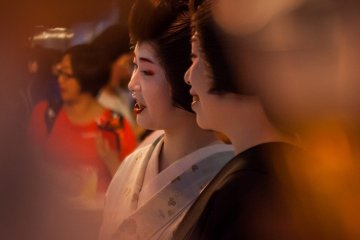
Gion Matsuri di Kyoto adalah festival yang penting di Jepang . Dimulai sejak tahun 869, di selenggarakan setipa tahun di bulan Juli

Gion Matsuri merupakan festival tertua dan paling dicintai di Jepang. Namun, ada juga festival yang tidak terlalu dikenal yang disebut Festival Shinko yang berlangsung pada malam yang sama dengan Gion Matsuri pada 17 Juli. Di sini, tiga tandu besar diangkut dari Kuil Yasaka dan dipanggul di sekitar kota setelahnya. Tandu-tandu melambangkan Dewa yang sangat terhubung dengan Festival Gion. Bergabunglah dengan kerumunan yang berjumlah ribuan orang untuk merayakan festival ini.

Hotel nyaman dengan fasilitas mandi spa di kamar dan sarapan gratis, berlokasi di pusat Kyoto

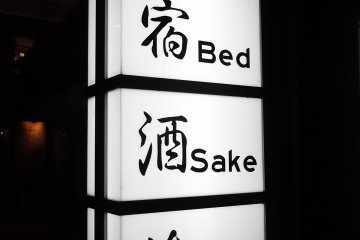
Di bekas ibukota Jepang di Kyoto, Jam Hostel Kyoto Gion adalah hostel ramah untuk backpackers, lokasinya pusat dan nyaman dalam hal transportasi, jalan-jalan, belanja dan kehidupan malam.
![Museum Udon, Kyoto [Tutup] Museum Udon, Kyoto [Tutup]](https://a2.cdn.japantravel.com/photo/16830-99298/360x240!/kyoto-the-udon-museum-kyoto-99298.jpg)
Mengenal dan mencicipi semua jenis udon Jepang di Museum Udon di Kyoto
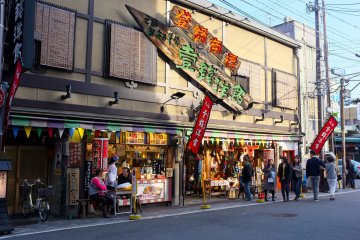
Kyoto terkenal dengan banyak hal. Tetapi saat berbicara makanan, Issen Yoshoku salah satu makanan yang direkomendasikan untuk tidak dilewatkan.

Masakan barat 'MIKAKU', Gion Shirakawa, Kyoto; Ketika Saya berjalan mengelilingi jalan sepanjang sungai Shirakawa, restoran indah bergaya pinggir sungai bercahaya di bawah sinar lembut menarik perhatian, dan tiba-tiba Saya ingin masuk ke sana.
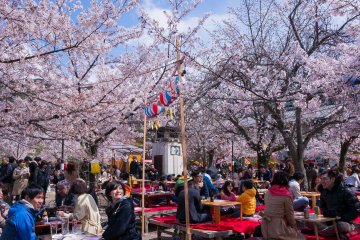
Maruyama Park is the oldest public park in Kyoto and a popular springtime cherry blossom viewing spot. It opened in 1886 and is located next to Yasaka Shrine in Higashiyama District. The park was laid out by the well-known gardening expert Ogawa Jibee (1860–1933). As it is one of the most popular places for hanami in Kyoto, it can get quite crowded during the high season in April. The main attraction of the park is a beautiful weeping cherry that is illuminated at night. In the southwest of the park is the Chorakukan Villa, which the Japanese tobacco king Murai Kichibee had built. This property is now used as a hotel.
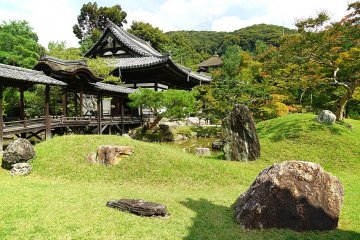
Kodaiji (高台寺) is located northeast of the Yasaka Hokanji Temple at the foot of the Higashiyama Ryozen Mountains in Kyoto. The official name of the temple is Kodaiji-Jushozenji Temple. In 1606, the temple of Kita-no-Mandokoro was dedicated in memory of her late husband. Kita-no-Mandokoro was also known as nene. The Kaisando (Founder's Hall), Otama-ya (Sanctuary), Kasatei (Tea House), Shiguretei (Tea House), Omotetmon (Gate to the Sanctuary), and Kangetsudai (Moon Viewing Pavilion) are designated as important cultural assets in Japan. The temple garden is said to have been designed by the landscape gardener Kobori Enshu (1579-1647). The Japanese government has designated the garden as a historic site and a place of scenic beauty. The interior of the main building was originally painted with lacquer and covered with exquisite gold decorations. However, the current building was rebuilt in 1912 after several fires. Kodai-ji hosts modern art exhibitions in spring and fall. These are set up in the rock garden in front of Houjyo and are creatively illuminated at night.
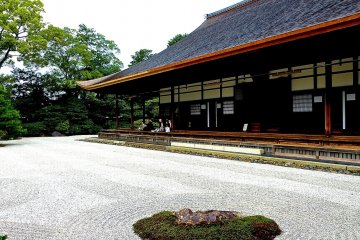
Kennin-ji is a historic Zen Buddhist temple in Higashiyama, Kyoto, Japan, near Gion, at the end of Hanami Lane. It is considered to be one of the so-called Kyoto Gozan or "five most important Zen temples of Kyoto". [Wikipedia]